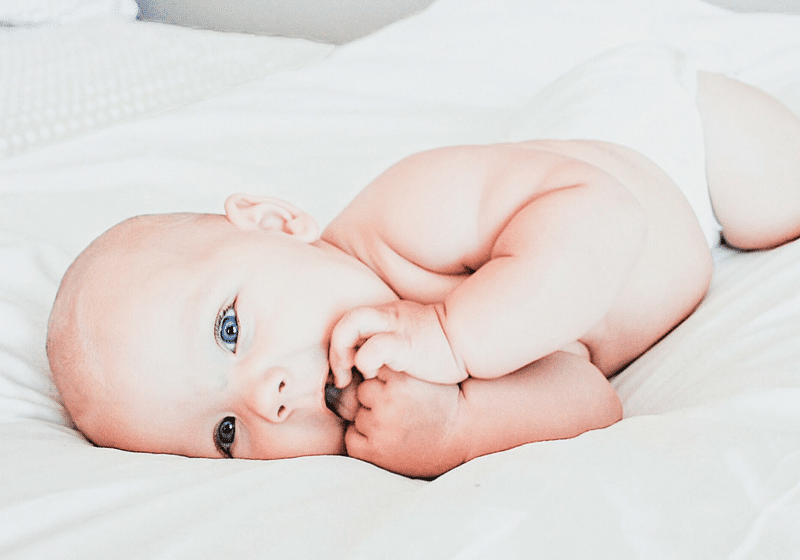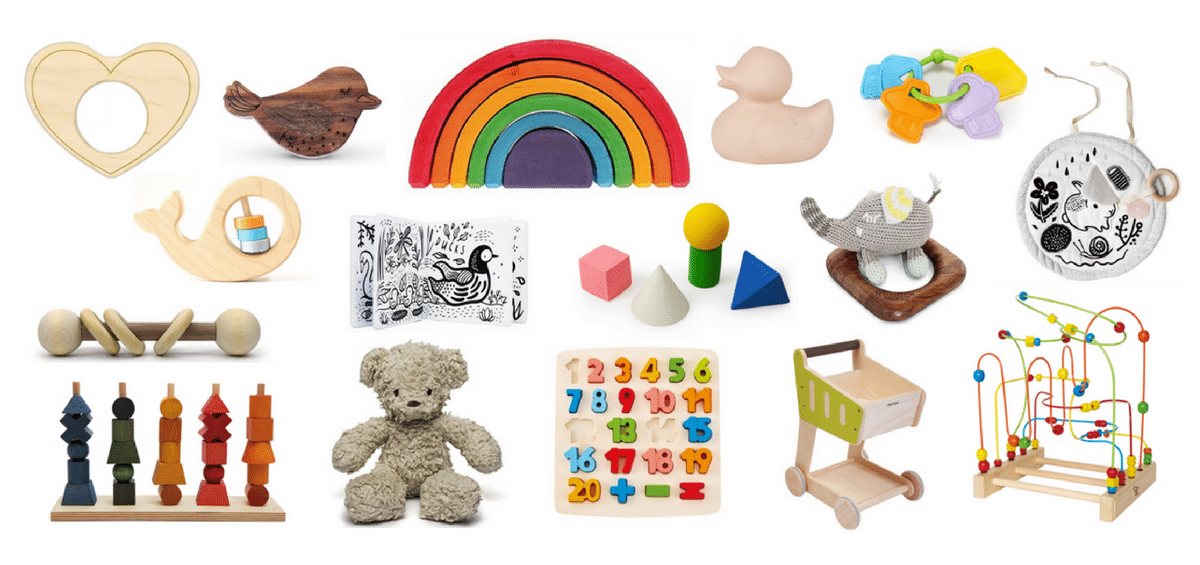Learn some amazing, weird, and surprising things about those tiny little humans we adore in this list of 50 fun facts about babies you want to know before you have one!
Babies are adorable, fragile, innocent little humans but they are also extremely complex little creatures!
I recently came across some really fun facts about babies that I was so surprised I had never heard before or facts I had completely wrong.
As I read through some more facts about babies, I kept thinking to myself, “I feel like someone should have told me about this at the hospital after I gave birth!” (Refer to fact #46)
Click here to learn 37 things you must have on your baby registry
Feeling like I needed to spread the love, I decided to compile a list of fun facts about babies you want to know before you have one.
Some of these facts are just cool to know and some of them you’re really going to want to know in order to be fully prepared for your newborn, at least mentally.
Basically, if you’re about to become a parent and you have a few minutes, read through this list and become aquatinted with your surprisingly sophisticated and totally weird future roommate!
Here are 50 fun facts about babies you want to know before you have one
1. No kneecaps
Babies are born without kneecaps. Well, technically they have kneecaps but they are still soft cartilage and only appear as little smudges on an x-ray. Your baby’s knees won’t be completely ossified for 3-5 years!
2. Lots of bones
Babies have more bones than adults do, 300 bones to be exact! When babies are born not all of their bones have fused together, so as they get older, and their bones fuse together, they will have 206 bones like every other adult.
3. Nose breathers
Babies are often called obligate or preferential nasal breathers. For the first few months of life, babies only breathe through their mouths when crying.
4. Cute for a reason
Newborns are designed to elicit a strong emotional and protective response from their parents. Their big eyes, chubby bodies, and sweet little noses give parents the need to provide comfort and safety. Apparently, cartoon artists intensify those exact features when they want a baby to look cute on screen.
5. No color
For the first 3 months of life, babies can only see in black and white.
6. Math geniuses
Babies have an elementary knowledge of physics and math! They know how to tell the difference between a set of objects and will notice if one is taken away, added, or even how many remain.
7. Nearsighted
For the first three months, babies can only see things approximately 8-12 inches away from their faces. This allows them to be able to see their own hands and body. It’s also the distance between their face and their parent’s face when being held or breastfed.
8. Tone readers
Babies can recognize the tone of your voice and respond to it appropriately. So even if you are saying something nice with a smile on your face, if your tone is angry they will react to the anger.
9. Professional growers
If your baby continued his first year’s growth rate, he would be 170 feet tall by the time he becomes an adult!
10. Big brains
A baby’s brain will double in size in its first year of life. That means that by the time they are 1-year-old their brain will be 60% of an adult size brain.
11. Temperature control
New babies have instinctive reactions to temperatures. If they get too hot, they will stretch their arms and legs out. If they get too cold, they will move around more to warm themselves up.
12. Surprise!
A baby is born on its predicted due date only 4% of the time.
13. Slow to warm up
Right after a baby is born, it takes them 5 to 10 minutes to become used to something new in their environment. When a baby is around 3 months old, they are able to adapt between 30 seconds and two minutes. By the time a baby is 6 months old, it can adapt in around 30 seconds.
14. Smiles all around
A baby’s smile is instinctive and not from watching and learning as originally believed. We know this because even blind babies know how to smile.
15. Super smell
A baby’s sense of smell is much more advanced than an adult’s. They use this acute sense of smell to get to know their parents.
16. Mama’s voice is magical
During the last 10 weeks of pregnancy, babies are listening closely to their mother’s voice. So after they are born, babies are able to recognize their mother’s voice.
17. Milk lovers
The instinct to breastfeed after being born is so strong that babies have actually been known to crawl up their mother’s chest to nurse.
18. Baby talk
According to psychologists, parents instinctively talk to their babies in a low-keyed speech rhythm called “Motherese” which babies naturally respond to in a positive way.
19. Holy crap…literally
From birth to being potty trained, a child goes through roughly 8000 diaper changes!
20. Emotionally perceptive
Even inside the womb, babies respond to their mother’s emotions and feelings. During a study, researchers found when mothers listened to music they enjoyed through headphones the babies were more active. This means they were responding to how the mother was feeling about the music and not the music itself.
21. Sweet tooth
Babies can’t taste salt until about 4 months old, but they have a keen sense of sweet, bitter, and sour flavors. Breastmilk is very sweet, which is why babies love it.
22. It’s Normal. Period.
Female babies can menstruate after birth. In the womb, babies are exposed to extremely high levels of estrogen. After a baby is born, those estrogen levels drop significantly and quickly, which causes something called pseudo menstruation. This means you might find a little blood in your baby’s diaper during her first week of life, but don’t worry because it’s completely normal.
23. Angel kisses
Birthmarks on babies are very common and about one-third of all babies are born with one or more of them.
24. Mom isn’t the only one lactating
Baby boys and girls can lactate. Sometimes that post-birth quick drop in estrogen can also cause something called galactorrhea, which is when newborns develop small breast buds and produce tiny amounts of milk from their nipples. It happens to about 5% of all babies and can last up to 2 months.
25. Music lovers
Babies remain calm twice as long when listening to a song as they do when listening to regular speech.
26. Experienced taste buds
The taste of what a mother eats while pregnant is transferred to the amniotic fluid that the baby floats in. Because babies develop taste buds very early on in the womb, they can taste what the mother eats. Then, after they are born babies will remember those tastes and be drawn to those types of food later on in life. No wonder my daughter loves sour candy!
27. Hair everywhere
During their time in the womb, babies‘ bodies are covered in a thin layer of hair called lanugo. During the last few weeks of pregnancy that layer of hair starts to shed. However, some babies are born before all that hair has fallen off. It’s actually pretty common, so don’t be worried if your baby is a bit hairy for the first few weeks.
28. Tiny tummies
At birth, a newborn’s stomach is about the size of a hazelnut. At 3 days old, it’s grown to the size of a large marble. By 10 days old, it’s the size of a golf ball.
29. Skip the swimming
Some people think that babies are born with the natural ability to swim because of a reflex called a bradycardic response, which is when babies naturally open their eyes and hold their breath when submerged in water. They will also naturally move their arms and legs around when placed on water tummy-side down. However, despite these awesome reflexes babies cannot actually swim on their own!
30. Fluctuating weight
It’s normal for newborns to lose 5 to 10 percent of their body weight after birth. They are born with some extra fluid which is lost within the first few days. Healthy babies should be back to their birth weight within two weeks.
31. The first poop
For the first two days of their life, a baby’s poop is very different than it will be later on. This poop is called meconium and is dark green or black, thick, and sticky. It is made up of intestinal cells, the lanugo (hair) they shed in the womb, mucus, amniotic fluid, bile, and water.
32. Familiar sounds
Babies will be soothed by sounds that remind them of the rhythmic sounds they heard in the womb, like their mother’s heartbeat. They may be why babies love falling asleep on people’s chests!
33. Memory boost
Apparently, nap time helps with memory. According to a study, if a baby takes a nap after they learn something new they are much more likely to remember and retain what they had learned after they wake up.
34. Crazy sleep schedule
Newborns do not know the difference between daytime and nighttime. As a matter of fact, sometimes their sleep schedule will be completely reversed. They will sleep more during daylight and be more alert during the night. It takes about a month for babies to develop more normal day/night sleep patterns.
35. Boys vs. Girls
There are differences between a baby girl’s and a baby boy’s brains. Boy’s brains grow faster than girls in the first three months of life, especially the parts of the brain that control movement and coordination. Also, the senses of baby girls, like vision and hearing, are more sensitive than baby boys.
36. Multitaskers
Babies can breathe and swallow at the same time until 7 months of age.
37. Cold feet
A newborn’s circulatory system is not completely developed when they are born. That means until babies are around three months old, their blood supply is more readily being sent to vital organs, and hands and feet are the last priority. As a result, it is completely normal for a baby’s fingers and toes to be very cold!
38. Tear-free
Although newborns cry a lot, they don’t have tears. Because newborn tear ducts can take 3-12 weeks to develop completely, they only produce nonemotional tears called basal tears to keep their eyes moist.
39. Gesundheit
Babies are known to sneeze a lot, but not because of being sick or having allergies. It is completely normal and just their body’s way of clearing their small nasal passages.
40. Big Heads
A baby’s head grows super fast! An average adult has a head has a circumference of 22 inches. Babies are born with an average head circumference of 12 inches and by one-year-old babies will have a head circumference of 18 inches. That means over half of their total head growth happens within one year!
41. Highly observant
According to a study, babies who are 3 to 4 months old have the ability to notice small differences in similar images. This is an ability that is lost as we grow older to help us recognize the same objects in different scenarios. It is an ability called perceptual consistency.
42. One cup
A newborn baby has about one cup of blood in its body when they are born.
43. Goodbye sleep
Statistics state that on average, parents will miss out on 6 months of sleep in the first two years of their child’s life. Crazy!
44. Tons of taste buds
Babies have three times as many taste buds as adults, over 10,000 on the sides, roof, and back of the mouth. As babies get older, they will start to lose those extra taste buds.
45. Very self-aware
Babies are born with a self-awareness that allows them to differentiate their bodies from other people.
46. Be careful with those kisses
Kissing a baby on the ear can make them go deaf because of a condition that is known as cochlear ear-kiss injury. This happens when a kiss on the ear creates a strong suction that pulls on the eardrum resulting in hearing loss. Spread the word on this one!
47. Myth busted
Despite the common belief that a baby’s eyes are full-grown at birth and never change, they are actually only about 75% the size of an adult eye.
48. Smooth move
Breastfed babies poop more frequently and easily than formula-fed babies because breastmilk is a natural laxative.
49. Hey there Flo
When your baby spends time in front of the mirror it may seem like they are basking in their own beauty. However, babies won’t realize it is their own reflection in the mirror until around 18 months old. Until then, mirror time is purely a social activity between two very similar-looking friends. (Did you get my Finding Nemo reference?)
50. Listen carefully
Apparently, babies have accents when they cry. That means babies from around the globe will cry with the same cadence and melody as their native language.
Babies are amazing yet totally weird, huh?
Well, there you have it! Now you know 50 fun facts about babies, which means you won’t be completely caught off guard when your baby comes out looking like a werewolf and cries with no tears.
You probably also realized that babies are more than just cute chubby faces and you shouldn’t underestimate how incredibly amazing and smart they actually are!
Just don’t get too thrown off by how weird they can be too, like the fact that they eat their own hair in the womb. Uh, you know what…maybe just forget you read that one.

Sources:
Bizarre Facts About Newborn Babies
21 Awesome Facts About Your Baby






It’s interesting to know that babies have a more advanced sense of smell compared to adults. It reminded me of my sister who just gave birth to a really cute son that everyone in the family adores. Maybe enrolling him in an infant curriculum would be a good idea for his development.